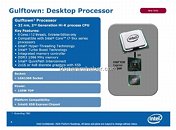Friday, August 7th 2009

Gulftown Seamlessly Compatible with X58 Chipset Platform
Nearly an year away from launch, Intel's 6-core Gulftown processor is creating buzz in the media. The new processor which has already been sampled, and tested, some of its first documentation has been leaked to the media in the form of a slide that lists out some details. To begin with, Gulftown will be the first high-performance processor built on the 32 nm second-generation HKMG process. Intel's first commercial 32 nm based processors are dual-core chips which will sell alongside the much larger 45 nm CPU lineup. Next of-course, is that it has six processing cores with HyperThreading enabling 12 logical CPUs. With TurboBoost, the processor powers down inactive cores and overclocks the active ones, thus boosting performance on single/few-threaded apps while reducing power consumption.
Next up is its integrated memory controller supporting DDR3-1066 memory. The same standard is listed for current Core i7 processors, though they are proven to work at higher memory bus speeds. The part that perhaps matters the most is that the processor is seamlessly compatible with the X58 chipset, is based on socket LGA-1366, and has the same TDP rating as Core i7 900 series processors: 130W. Existing motherboards that handle Core i7 processors are technically capable to handle Gulftown. The processor will only be available in the high-end (enthusiast) category, and according to the latest roadmaps, is slated for Q2 2010.
Source:
DonanimHaber
Next up is its integrated memory controller supporting DDR3-1066 memory. The same standard is listed for current Core i7 processors, though they are proven to work at higher memory bus speeds. The part that perhaps matters the most is that the processor is seamlessly compatible with the X58 chipset, is based on socket LGA-1366, and has the same TDP rating as Core i7 900 series processors: 130W. Existing motherboards that handle Core i7 processors are technically capable to handle Gulftown. The processor will only be available in the high-end (enthusiast) category, and according to the latest roadmaps, is slated for Q2 2010.

38 Comments on Gulftown Seamlessly Compatible with X58 Chipset Platform
Anyone notice on the pic it says "Extreme Edition" only?
Does that mean only extreme will have the 12 threads?
Confused...
Cool stuff.
Unfortunately I won't buy EE. Will have to wait a bit longer than Q2/2010 to go 6-core.
12 threads FTW, 130W TDP FTL
Secondly, Gulftown will only be Extreme Edition, as Intel is moving the rest of the Core i7 processors to the LGA-1156 platform, so everyone with an LGA-1366 is either going to have to make do with what they have or go EE...
An i7 next year will still be better than 95% of everything else out there. Heck it'll stand up to the next few years.
Core i9 is exclusive to LGA-1366.
Core i7 has some LGA-1366 models and some LGA-1156 models.
Core i5, as of now, is exclusive to LGA-1156 (it could appear on mobile processors too).
A Core i9 CPU alone is going to be out of the budget range of the lion share of consumers.
As it's not out until Q2'10 there's still some time to go before Intel will set that in stone, but on all current roadmaps it's listed as a Core i7 Extreme Edition CPU with a "branding to be decided" moniker. There are no Gulftown based consumer CPU's outside of the Extreme category on the roadmaps either.
On top of that, there are no more LGA-1366 parts after the Core i7 960/920, but then again, this might very well change in the future, but as of right now, it seems like Intel is focusing on the LGA-1156 platform for consumers.
Still, I didn't say that the current LGA-1366 was a bad choice if you already own it, all I was saying that Gulftown is unlikely to be an upgrade path for most people.
forums.techpowerup.com/showthread.php?t=100766
It doesn't have the model numbers though so I'm still a sceptic. Actually, looking at the roadmap, i# doesn't mean anything--the 920, 850, 975, etc. does. I'm guessing Gulftown will be 985 or 995 and 975 is the last quad-core Extreme Edition processor.
If Gulftown is only available as an Extreme Edition processor, I agree, very few people will have them.
I'm just shocked that Westmere (32nm) is hitting shelves with Nehalem (45nm) barely exisiting (only five processors planned for Nehalem, some already discontinued).
Besides Lynnfield (aka Core i7/i5 LGA-1156) is Nehalem based. LGA-1366 Core i7 were codenamed Bloomfield but were derived from the Nehalem architecture and Westmere is the 32nm version of Nehalem. Clarkdale is in turn based on the Westmere core.
The difference is that Intel decided to go and do a cheaper general consumer range and I guess triple-channel DDR3 wasn't the hit they expected it to be. Oddly enough, you'd think they'd stick with it now that they've put the memory controller on-chip, but alas, no...
Who knows what Intel is thinking? But it seems like they're moving forward in very strange circles and keep repeating historical mistakes in slightly new ways...
There's only two things different about Nehalem that wasn't there on the original Netburst codename: multi-core and turbo mode. Multi-core because the dual- and quad-core revolution didn't start until 2005 and turbo mode was a revival from the 286, 386, and 486. I have no idea why they did. Perhaps it is because Nehalem has a core clock of 133 MHz so 1x or 2x more on the multiplier isn't going to hurt anything.